R. Thukral
Padé Research Centre, 39 Deanswood Hill, Leeds, England
Correspondence to: R. Thukral, Padé Research Centre, 39 Deanswood Hill, Leeds, England.
| Email: |  |
Copyright © 2015 Scientific & Academic Publishing. All Rights Reserved.
Abstract
The aims of this paper are, firstly, to define a new third-order Schroder-type method for finding zeros of nonlinear equations having unknown multiplicity and secondly, to introduce a new formula for approximating the multiplicity of the iterative method. In terms of computational cost the new iterative method requires four evaluations of functions per iteration. It is proved that the new method has a convergence of order three. Numerical comparisons are included to demonstrate exceptional convergence speed of the proposed method.
Keywords:
Schroder-type method, Root-finding, Nonlinear equations, Multiple roots, Order of convergence, Efficiency index
Cite this paper: R. Thukral, New Third-Order Schroder-Type Method for Finding Zeros of Nonlinear Equations Having Unknown Multiplicity, American Journal of Computational and Applied Mathematics , Vol. 5 No. 5, 2015, pp. 147-153. doi: 10.5923/j.ajcam.20150505.03.
1. Introduction
Solving nonlinear equations is one of the most important problems in numerical analysis. In this paper, we consider iterative methods to find a multiple root  of multiplicity m, i.e.,
of multiplicity m, i.e.,  and
and  of a nonlinear equation
of a nonlinear equation  | (1) |
where is a scalar function on an open interval I and it is sufficiently smooth in the neighbourhood of
is a scalar function on an open interval I and it is sufficiently smooth in the neighbourhood of  In recent years, some modifications of the Newton-type methods for multiple roots have been proposed and analysed [3, 6-8]. We have found that there are not many methods known to handle the case when multiplicity is unknown, hence we present a new method for finding multiple zeros of a nonlinear equation, based on four evaluations of the function per iteration. In this study we have developed a new iterative method for finding multiple roots of nonlinear equations of a higher order than the existing well-known iterative methods [4-6]. Furthermore, in this paper we have shown further development of the second-order methods [4-6]. In addition, the new iterative method has a better efficiency index than the classical Schroder method and Noor et al. methods [4]. Hence, the proposed third-order method is significantly better when compared with these established methods.The structure of this paper is as follows. Some basic definitions relevant to the present work are presented in section 2. In section 3, the new iterative method is defined and proved. In section 4, new and recently presented formulas for approximating the multiplicity of the iterative methods are described. In section 5, well-established methods are stated, which will demonstrate the effectiveness of the new third-order iterative method. Finally, in section 6, numerical comparisons are made to demonstrate the performance of the presented method.
In recent years, some modifications of the Newton-type methods for multiple roots have been proposed and analysed [3, 6-8]. We have found that there are not many methods known to handle the case when multiplicity is unknown, hence we present a new method for finding multiple zeros of a nonlinear equation, based on four evaluations of the function per iteration. In this study we have developed a new iterative method for finding multiple roots of nonlinear equations of a higher order than the existing well-known iterative methods [4-6]. Furthermore, in this paper we have shown further development of the second-order methods [4-6]. In addition, the new iterative method has a better efficiency index than the classical Schroder method and Noor et al. methods [4]. Hence, the proposed third-order method is significantly better when compared with these established methods.The structure of this paper is as follows. Some basic definitions relevant to the present work are presented in section 2. In section 3, the new iterative method is defined and proved. In section 4, new and recently presented formulas for approximating the multiplicity of the iterative methods are described. In section 5, well-established methods are stated, which will demonstrate the effectiveness of the new third-order iterative method. Finally, in section 6, numerical comparisons are made to demonstrate the performance of the presented method.
2. Basic Definitions
In order to establish the order of convergence of the new third-order method, we use the following definitions.Definition 1 Let  be a real-valued function with a root
be a real-valued function with a root  and let
and let  be a sequence of real numbers that converge towards
be a sequence of real numbers that converge towards  The order of convergence p is given by
The order of convergence p is given by | (1) |
where  and
and  is the asymptotic error constant [1, 3, 9]. Definition 2 Let
is the asymptotic error constant [1, 3, 9]. Definition 2 Let  be the error in the kth iteration, then the relation
be the error in the kth iteration, then the relation | (2) |
is the error equation. If the error equation exists, then p is the order of convergence of the iterative method [1, 3, 9].Definition 3 Let r be the number of function evaluations of the method. The efficiency of the method is measured by the concept of efficiency index and defined as | (3) |
where p is the order of convergence of the method [1,3,9].Definition 4 Suppose that  and
and  are three successive iterations closer to the root
are three successive iterations closer to the root  . Then the computational order of convergence may be approximated by
. Then the computational order of convergence may be approximated by  | (4) |
where 
3. Development of the Method and Convergence Analysis
In this section we define a new third-order iterative method for finding multiple roots of a nonlinear equation. In order to construct the new iterative method we require one function and three derivatives evaluations. The scheme is given as | (5) |
where  is the initial guess and provided that the denominator of (5) is not equal to zero. We have found that the formula (5) can also be expressed as
is the initial guess and provided that the denominator of (5) is not equal to zero. We have found that the formula (5) can also be expressed as | (6) |
 | (7) |
where | (8) |
Theorem 1 Let  be a multiple zero of a sufficiently differentiable function
be a multiple zero of a sufficiently differentiable function  for an open interval I with multiplicity m, which includes
for an open interval I with multiplicity m, which includes  as an initial guess of
as an initial guess of  Then the iterative method defined by scheme (5) has third-order convergence.Proof Let
Then the iterative method defined by scheme (5) has third-order convergence.Proof Let  be a multiple root of multiplicity m of a sufficiently differentiable function
be a multiple root of multiplicity m of a sufficiently differentiable function  Using the Taylor series expansion of
Using the Taylor series expansion of  about
about  , we have
, we have | (9) |
 | (10) |
 | (11) |
 | (12) |
where  and
and  | (13) |
 | (14) |
 | (15) |
 | (16) |
 | (17) |
Substituting appropriate expressions in (5),  | (18) |
Simplifying (18), we obtain the asymptotic error constant | (19) |
The expression (19) establishes the asymptotic error constant for the third-order of convergence for the new Schroder-type method defined by (5).
4. Formulas for Approximating the Multiplicity
In this section, we state some of the recently presented formulas to approximate the multiplicity m of the method given in [7]. First we state the classical Lagouanelle formula [2] for approximating the multiplicity m given as | (20) |
and the new improved formula for approximating the multiplicity m expressed as  | (21) |
In [7] Thukral presented new alternative formulas for approximating the multiplicity m which are expressed as | (22) |
 | (23) |
 | (24) |
 | (25) |
 | (26) |
where | (27) |
The approximations of m are obtained by these formulas are based on the estimates of (5) and the errors of the above approximants are given by | (28) |
and the performance of these formulas are displayed in the table 4 and 5.
5. The Established Methods
For the purpose of comparison, four iterative methods presented in [4] are considered. Since these methods are well established, the essential formulas are used to calculate the approximate solution of the given nonlinear equations and thus compare the effectiveness of the new third-order method. The first of the methods is the classical Schroder second-order method presented in [5] and is expressed as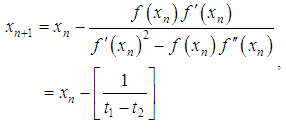 | (29) |
where  are given by (8). The other four second-order methods are by Noor et al. and are presented in [4], and the general form of the method is expressed as
are given by (8). The other four second-order methods are by Noor et al. and are presented in [4], and the general form of the method is expressed as | (30) |
with a suitable choice of  and a parameter
and a parameter  the four particular methods are formed as
the four particular methods are formed as | (31) |
 | (32) |
 | (33) |
 | (34) |
Further details of construction of the above formulas are given [4].
6. Numerical Results
In this section, we shall present the numerical results obtained by employing the iterative methods (5), (29)-(33) to solve some nonlinear equations with unknown multiplicity m. To demonstrate the performance of the new higher order iterative methods, we use ten particular nonlinear equations. The consistency and stability of the results are determined by examining the convergence of the new iterative methods. The findings are generalised by illustrating the effectiveness of the higher order methods for determining the multiple root of a nonlinear equation. Consequently, the errors obtained by each of the methods are displayed in the following tables. In fact, the errors displayed are of absolute value and insignificant approximations by the various methods have been omitted in the following tables. The numerical computations listed in the tables were performed on an algebraic system called Maple.The new third-order method requires four function evaluations and has the order of convergence three. To determine the efficiency index of the new method, definition 3 will be used. Hence, the efficiency index of the new method given by (5) is  whereas the efficiency index of the second-order methods (29)-(34) is given by
whereas the efficiency index of the second-order methods (29)-(34) is given by  . We can see that the efficiency index of the new third-order method has a better efficiency index than the second-order methods. The test functions, multiplicity m and their exact root
. We can see that the efficiency index of the new third-order method has a better efficiency index than the second-order methods. The test functions, multiplicity m and their exact root  are displayed in table 1. The difference between the root
are displayed in table 1. The difference between the root  and the approximation
and the approximation  for test functions with initial guess
for test functions with initial guess  are displayed in table 2. Table 2 shows the absolute errors obtained by each of iterative methods described, we see that the new third order method is producing better results than the established methods. Furthermore, the computational order of convergence (COC) are displayed in table 3. From the table 3, we observe that the COC perfectly coincides with the theoretical result.
are displayed in table 2. Table 2 shows the absolute errors obtained by each of iterative methods described, we see that the new third order method is producing better results than the established methods. Furthermore, the computational order of convergence (COC) are displayed in table 3. From the table 3, we observe that the COC perfectly coincides with the theoretical result.Table 1. Test functions, multiplicity m, root α and initial guess x0
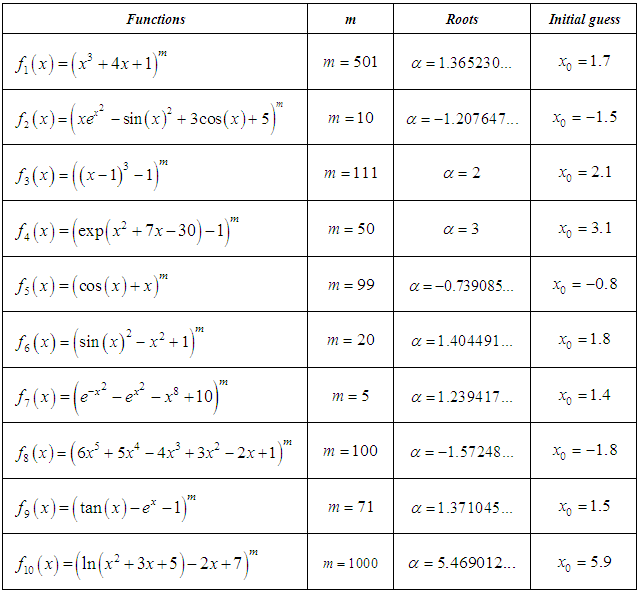 |
| |
|
Table 2. Comparison of iterative methods
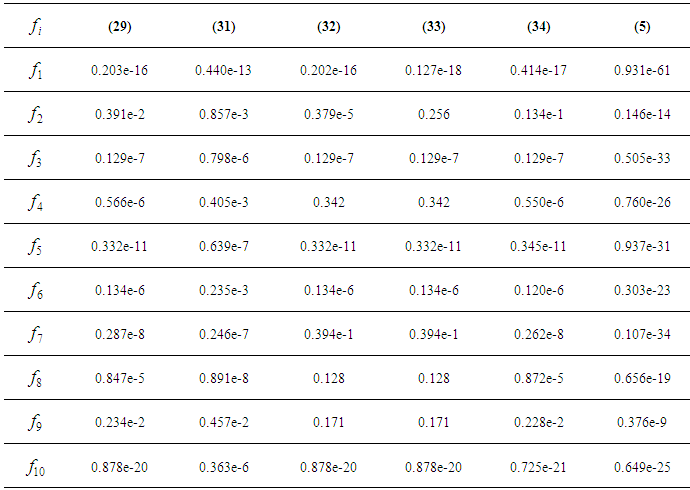 |
| |
|
Table 3. Performance of COC
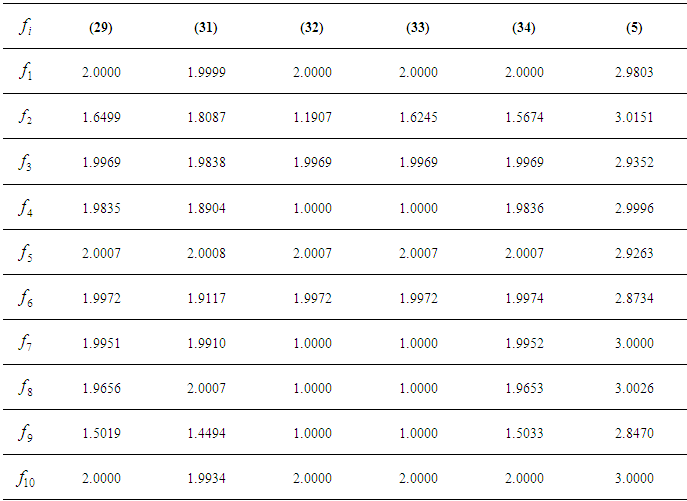 |
| |
|
In addition, the difference between the multiplicity m and the approximation  based on the present method (5) are displayed in table 4. In table 4 we see a remarkable precision of the multiplicity m and there is no significant difference between the Lagouanelle formula (20) and the recently introduced formulas (22)-(26). Furthermore, in table 5 we display the difference between the multiplicity m and the approximation
based on the present method (5) are displayed in table 4. In table 4 we see a remarkable precision of the multiplicity m and there is no significant difference between the Lagouanelle formula (20) and the recently introduced formulas (22)-(26). Furthermore, in table 5 we display the difference between the multiplicity m and the approximation  based on the Schroder method (29). As before, we find that there is no significant difference between the formulas, they are all performing equally. As expected, we see a remarkable precision of the multiplicity m based on new formula (5) approximants are significant better than the approximants of the Schroder method (29). In fact,
based on the Schroder method (29). As before, we find that there is no significant difference between the formulas, they are all performing equally. As expected, we see a remarkable precision of the multiplicity m based on new formula (5) approximants are significant better than the approximants of the Schroder method (29). In fact,  is calculated by using the same total number of function evaluations (TNFE) for all methods.
is calculated by using the same total number of function evaluations (TNFE) for all methods.Table 4. Performance of multiplicity m, based on the approximants of (5)
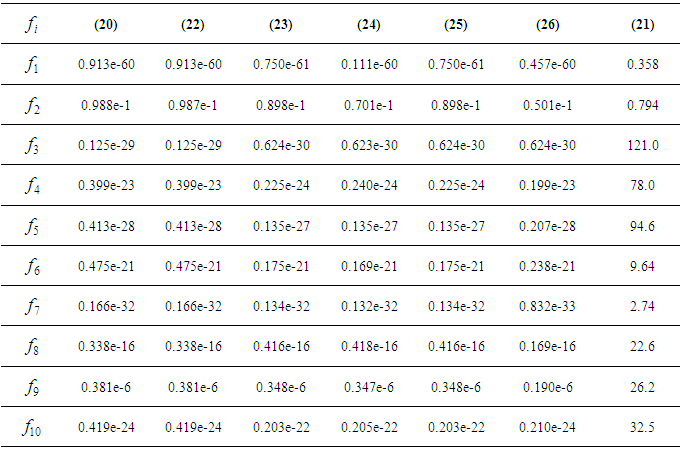 |
| |
|
Table 5. Performance of multiplicity m, based on the approximants of (29)
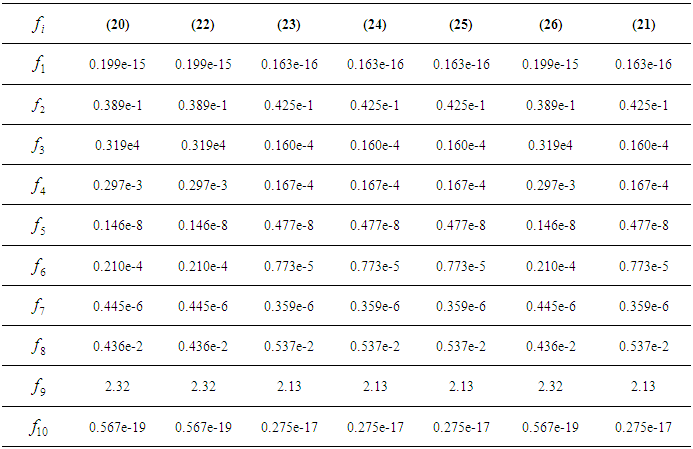 |
| |
|
7. Conclusions
In this paper, a new third-order iterative method for solving nonlinear equations with multiple roots has been introduced. Convergence analysis proves that the new method preserve the order of convergence. The prime motive for presenting the new method was to establish a higher order of convergence method than the existing second order methods [4]. The effectiveness of the new third-order method is examined by showing the accuracy of the multiple roots of several nonlinear equations. After an extensive experimentation, it can be concluded that the convergence of the new third-order method is remarkably fast. The main purpose of demonstrating the new method for different types of nonlinear equations was purely to illustrate the accuracy of the approximate solution, the stability of the convergence, the consistency of the results and to determine the efficiency of the new iterative method. We have shown numerically, and verified, that the new iterative method converge to the order three. Empirically, we have found that the approximants obtained by the new third order method is producing better precision of the multiplicity m than the approximants of classical Schroder second order method. Finally, we have constructed a new higher order iterative method with better efficiency index than the existing second order methods, but unfortunately the new method is not of optimal order, hence further investigation is essential.
References
| [1] | W. Gautschi, Numerical Analysis: an Introduction, Birkhauser, 1997. |
| [2] | J. L. Lagouanelle, Sur une mtode de calcul de l’ordre de multiplicity des zros d’un polynme, C. R. Acad. Sci. Paris Sr. A 262 (1966) 626-627. |
| [3] | M. S. Petkovic, B. Neta, L. D. Petkovic, J. Dzunic, Multipoint methods for solving nonlinear equations, Elsevier 2012. |
| [4] | M. A. Noor, F. A. Shah, A family of iterative schemes for finding zeros of nonlinear equations having unknown multiplicity, Appl. Math. Inf. Sci. 8 (2014) 2367-2373. |
| [5] | E. Schroder, Uber unendich viele Algorithmen zur Auflosung der Gleichungen, Math. Ann. 2 (1870) 317-365. |
| [6] | R. Thukral, New variants of the Schroder method for finding zeros of nonlinear equations having unknown multiplicity, J. Adv. Math. 8 (3) (2014) 1675-1683. |
| [7] | R. Thukral, New modifications of Newton-type methods with eighth-order convergence for solving nonlinear equations, J. Adv. Math. 10 (3) (2015) 3362-3373. |
| [8] | R. Thukral, New twelfth order iterative methods for finding roots of nonlinear equations, Amer. J. Comput. Appl. Math. 5(2) (2015) 33-41. |
| [9] | J. F. Traub, Iterative Methods for solution of equations, Chelsea publishing company, New York 1977. |

 of multiplicity m, i.e.,
of multiplicity m, i.e.,  and
and  of a nonlinear equation
of a nonlinear equation 
 is a scalar function on an open interval I and it is sufficiently smooth in the neighbourhood of
is a scalar function on an open interval I and it is sufficiently smooth in the neighbourhood of  In recent years, some modifications of the Newton-type methods for multiple roots have been proposed and analysed [3, 6-8]. We have found that there are not many methods known to handle the case when multiplicity is unknown, hence we present a new method for finding multiple zeros of a nonlinear equation, based on four evaluations of the function per iteration. In this study we have developed a new iterative method for finding multiple roots of nonlinear equations of a higher order than the existing well-known iterative methods [4-6]. Furthermore, in this paper we have shown further development of the second-order methods [4-6]. In addition, the new iterative method has a better efficiency index than the classical Schroder method and Noor et al. methods [4]. Hence, the proposed third-order method is significantly better when compared with these established methods.The structure of this paper is as follows. Some basic definitions relevant to the present work are presented in section 2. In section 3, the new iterative method is defined and proved. In section 4, new and recently presented formulas for approximating the multiplicity of the iterative methods are described. In section 5, well-established methods are stated, which will demonstrate the effectiveness of the new third-order iterative method. Finally, in section 6, numerical comparisons are made to demonstrate the performance of the presented method.
In recent years, some modifications of the Newton-type methods for multiple roots have been proposed and analysed [3, 6-8]. We have found that there are not many methods known to handle the case when multiplicity is unknown, hence we present a new method for finding multiple zeros of a nonlinear equation, based on four evaluations of the function per iteration. In this study we have developed a new iterative method for finding multiple roots of nonlinear equations of a higher order than the existing well-known iterative methods [4-6]. Furthermore, in this paper we have shown further development of the second-order methods [4-6]. In addition, the new iterative method has a better efficiency index than the classical Schroder method and Noor et al. methods [4]. Hence, the proposed third-order method is significantly better when compared with these established methods.The structure of this paper is as follows. Some basic definitions relevant to the present work are presented in section 2. In section 3, the new iterative method is defined and proved. In section 4, new and recently presented formulas for approximating the multiplicity of the iterative methods are described. In section 5, well-established methods are stated, which will demonstrate the effectiveness of the new third-order iterative method. Finally, in section 6, numerical comparisons are made to demonstrate the performance of the presented method. be a real-valued function with a root
be a real-valued function with a root  and let
and let  be a sequence of real numbers that converge towards
be a sequence of real numbers that converge towards  The order of convergence p is given by
The order of convergence p is given by
 and
and  is the asymptotic error constant [1, 3, 9]. Definition 2 Let
is the asymptotic error constant [1, 3, 9]. Definition 2 Let  be the error in the kth iteration, then the relation
be the error in the kth iteration, then the relation

 and
and  are three successive iterations closer to the root
are three successive iterations closer to the root  . Then the computational order of convergence may be approximated by
. Then the computational order of convergence may be approximated by 


 is the initial guess and provided that the denominator of (5) is not equal to zero. We have found that the formula (5) can also be expressed as
is the initial guess and provided that the denominator of (5) is not equal to zero. We have found that the formula (5) can also be expressed as


 be a multiple zero of a sufficiently differentiable function
be a multiple zero of a sufficiently differentiable function  for an open interval I with multiplicity m, which includes
for an open interval I with multiplicity m, which includes  as an initial guess of
as an initial guess of  Then the iterative method defined by scheme (5) has third-order convergence.Proof Let
Then the iterative method defined by scheme (5) has third-order convergence.Proof Let  be a multiple root of multiplicity m of a sufficiently differentiable function
be a multiple root of multiplicity m of a sufficiently differentiable function  Using the Taylor series expansion of
Using the Taylor series expansion of  about
about  , we have
, we have



 and
and 
















 are given by (8). The other four second-order methods are by Noor et al. and are presented in [4], and the general form of the method is expressed as
are given by (8). The other four second-order methods are by Noor et al. and are presented in [4], and the general form of the method is expressed as
 and a parameter
and a parameter  the four particular methods are formed as
the four particular methods are formed as



 whereas the efficiency index of the second-order methods (29)-(34) is given by
whereas the efficiency index of the second-order methods (29)-(34) is given by  . We can see that the efficiency index of the new third-order method has a better efficiency index than the second-order methods. The test functions, multiplicity m and their exact root
. We can see that the efficiency index of the new third-order method has a better efficiency index than the second-order methods. The test functions, multiplicity m and their exact root  are displayed in table 1. The difference between the root
are displayed in table 1. The difference between the root  and the approximation
and the approximation  for test functions with initial guess
for test functions with initial guess  are displayed in table 2. Table 2 shows the absolute errors obtained by each of iterative methods described, we see that the new third order method is producing better results than the established methods. Furthermore, the computational order of convergence (COC) are displayed in table 3. From the table 3, we observe that the COC perfectly coincides with the theoretical result.
are displayed in table 2. Table 2 shows the absolute errors obtained by each of iterative methods described, we see that the new third order method is producing better results than the established methods. Furthermore, the computational order of convergence (COC) are displayed in table 3. From the table 3, we observe that the COC perfectly coincides with the theoretical result. based on the present method (5) are displayed in table 4. In table 4 we see a remarkable precision of the multiplicity m and there is no significant difference between the Lagouanelle formula (20) and the recently introduced formulas (22)-(26). Furthermore, in table 5 we display the difference between the multiplicity m and the approximation
based on the present method (5) are displayed in table 4. In table 4 we see a remarkable precision of the multiplicity m and there is no significant difference between the Lagouanelle formula (20) and the recently introduced formulas (22)-(26). Furthermore, in table 5 we display the difference between the multiplicity m and the approximation  based on the Schroder method (29). As before, we find that there is no significant difference between the formulas, they are all performing equally. As expected, we see a remarkable precision of the multiplicity m based on new formula (5) approximants are significant better than the approximants of the Schroder method (29). In fact,
based on the Schroder method (29). As before, we find that there is no significant difference between the formulas, they are all performing equally. As expected, we see a remarkable precision of the multiplicity m based on new formula (5) approximants are significant better than the approximants of the Schroder method (29). In fact,  is calculated by using the same total number of function evaluations (TNFE) for all methods.
is calculated by using the same total number of function evaluations (TNFE) for all methods. Abstract
Abstract Reference
Reference Full-Text PDF
Full-Text PDF Full-text HTML
Full-text HTML



